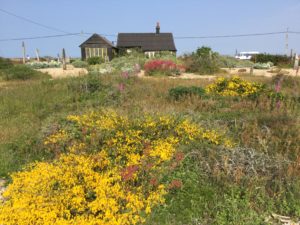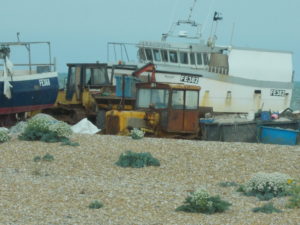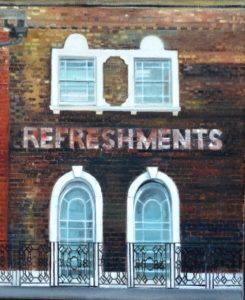Blue Door News, June – August
Dungeness and the National Gallery
The saga of clinic and hospital visits has continued to mark our calendar over the last couple of months. However, in June we managed a few days at Dungeness. It is really a unique landscape, as many will know, full of a variety of wild flowers, grasses, pebbles, and scrubland and the signs of a long-standing fishing culture. Quaint or, in increasing numbers, modernised sheds and cottages are pitched at random across the flat terrain, threaded by the Romney, Hythe and Dymchurch miniature railway (yes, we took a ride), while behind everything stands the Dungeness Nuclear Power Station.


We photographed everything and Pete did a pen and crayon sketch of Derek Jarman’s Prospect Cottage. He has also, now in early August, finished an oil painting of a scene commanded by a boardwalk stretching out to the sea.
This is included along with some other new work by us both in the Portfolio under ‘Recent Work’.
July came and went, first hot, then hotter. At the beginning of August we visited two related exhibitions at the National Gallery with American friends. These were ‘Thomas Cole Eden to Empire’ (including his series ‘The Course of Empire’, 1833-36) and the American artist, Ed Ruscha’s ‘Course of Empire’ (1992 and 2005) which clearly alludes to Cole’s series.
Cole was a largely self-taught English-born artist, influenced by Turner and Constable amongst others, who became a premier figure in the American landscape tradition. His ‘The Course of Empire’ depicts the ascendancy and decline of Empire from pastoral idyll to glory, defeat and devastation in large, appropriately epic canvasses. It is seen, as is the major work ‘View from Mount Holyoke’ also displayed in the exhibition, as a warning to America of the impending ruination of its natural riches signalled by the advance of mechanisation and uncontrolled growth. One thing which struck us all was Cole’s depiction of people, always miniature, and given allegorical roles as representing, say, the coming of farming, or art and learning, or the military. Their small size would seem to stand as lesson on the smallness of human society in the scale of things where the natural world is immense but imperilled.
Cole’s ‘The Course of Empire’ consists of five paintings. Ed Ruscha’s ‘Course of Empire’, without the definite article, comprises two series of five paintings each. The first titled ‘Blue Collar’ depicts five black and white canvases of premises in Los Angeles (or strictly the tops of these buildings), a Tool and Die factory, a Trade School, and a Telephone booth, for example. Set below them in the exhibition are depictions of the changed aspect of these same buildings in the present-day, now painted in colour. The logos have faded, The Tool and Die factory has swapped its title for Korean Style calligraphy and a wall of graffiti, the Trade School is boarded up and fenced off, and the Telephone booth is simply defunct in an age of digital communication ousted by a concrete telegraph pole and a tree. Ruscha himself does not own an iphone. Thomas Cole’s ‘hatred of the progress of mankind’, he says, would make him weep at the ‘poetry of change’ witnessed today. Of himself, he says he prefers the black and white world, Oddly enough, this is the ‘blue collar’ world gone missing for supporters of Donald Trump. But if Ruscha is nostalgic for a lost America, Trump is not the answer to present day woes. ‘Oh Boy’, he says in interview at the mention of Trump’s name; ‘the art world is still in shock’ at his election … We’re all sitting in an electric chair’.
Ruscha is probably best known for his homage to US gas stations and it would be good to catch up with this work. Meanwhile, in a critical note, while the present two exhibitions of Cole and Ruscha’s ‘Courses of Empire’ are evidently companion shows, and both splendid, they are installed on different floors some distance apart. There is no encouragement by the National Gallery to see them together, no directions on how best to physically get from one to the other, nor the simple guidance that it would be best to see the Cole first.
August 8th
An uncanny sequence of events: the Summer Special of the New Statesman includes the following poem by Hugo Williams:
Ghost Signs
I was trying to read your mind
in London’s palm, looking for reasons
in the blank faces of shops.
A ghost sign for REFRESHMENTS
high on the wall in York Way
and one for WEIGHING MACHINES
round the corner in Gray’s Inn Road,
were growing fainter, harder to read.
The sun was going down
on The Poor School of Performing Arts,
Espiritu Santo Hairstyles and Nails,
“Hurricane Pool Hall Opening Soon”,
a battered tin advertisement
spinning illegibly in the wind.
Hugo Williams had earlier written a set of poems on his experience of dialysis and had a transplant in 2014. We read these poems in the LRB and today Liz read his ‘Ghost Signs’ on her way to the Renal Department at Brighton Royal Sussex Hospital and pointed it out to me later. The route Williams takes in the poem was his route to the Dialysis Clinic at St Pancras. But she pointed it out for another reason too. The first ghost sign he describes was the subject of a painting I did last year

Some kind of serendipitous affinity of one kind and another at work here, it seems. Happenstance, you might say.